Games
PCB
Archive
Chip
Archive
Cart/Box
Scans
Articles
Peripherals
Prototypes
Unreleased
Games
Rarities
Homebrew
Emulation
Links
Email: snes_central@yahoo.ca
Nintendo Gateway SystemNintendo Gateway System |
 The Nintendo Gateway System was a networked interface to allow Super NES games to be played on airplanes and in hotels. Lodgenet was a utilization of it for hotels. By: Evan G |
The Nintendo Gateway System was a service designed to provide networked SNES gaming services. It was designed for airplanes (and was one of the first in-seat airline entertainment services, as far as I can tell) and hotels. Lodgenet was the most widespread pay-per-view system for hotels that used it. There was a summary of the Nintendo Gateway System on their (now dead) website, which gives a good overview of where you might have been able to use the system. I've copied the relevant sections below:
What is the Nintendo Gateway SystemTM?Unlike a traditional Nintendo video game console that one buys in a store and takes home, the Nintendo Gateway Systems is a proprietary hardware /software system available on commercial aircraft and hotel properties. Nintendo does not supply the host system, but instead integrates its technology into a service provider's entertainment delivery system.
Currently the Nintendo Gateway system has five different versions: the Super NES, N64, and GameCube configurations are offered for the hotel industry; and the Super NES, Game Boy Color, and Game Boy Advance versions are available for the airlines. The Nintendo Gateway System allows the lodging and airline industry worldwide to offer their customers the same fun and entertainment that millions of travelers already enjoy at home.
The Nintendo Gateway System was first launched for the airline industry in July 1993 and in the lodging industry in December 1993. The Nintendo Gateway System is presently in over 40,000 airline seats and more than 955,000 hotel rooms worldwide.
Airlines IFE Providers Air Canada
Alitalia
ANAbmi
China Airlines
Kuwait Airways
Malaysia Airlines
Singapore AirlinesThai Airways
Virgin Atlantic
Matsushita Avionics
Rockwell CollinsThales Avionics
Hotel Entertainment Systems
LodgeNet Entertainment
NXTV
Quadriga
Nintendo Gateway System
Fact Sheet
The Nintendo Gateway System combines the latest in digital communications technology with custom versions of the Nintendo GameCube, N64, Super NES, Game Boy Advance, and Game Boy Color platforms.
- Airline customers can enjoy Nintendo video games when sitting in one of over 40,000 airline seats equipped with the Nintendo Gateway Super NES, Game Boy Color, or Game Boy Advance systems.
- Hotel guests can relax with Nintendo video games when staying in one of 955,000 rooms worldwide with the Nintendo Gateway GameCube, N64 and / or Super NES systems.
Games available include among others the top-selling and all-time favorites:
Super NES titles - Super Mario World, Donkey Kong Country 2, and Super Punch Out
Nintendo 64 titles - Super Smash Bros, Excitebike, Mario Tennis, Paper Mario
Game Boy titles - Super Mario Bros. Deluxe, Pokémon Gold, Pokémon SilverGameCube titles - Mario Kart: Double Dash, Metroid Prime, Super Mario Sunshine
Game Boy Advance titles - Advance Wars 2, Warioland 4, Mario Pinball Land
Hotel Industry
LodgeNet Entertainment: LodgeNet is the first Nintendo Gateway distributor to offer Nintendo GameCube and N64 video games in addition to the Super NES titles. They provide Nintendo video games in the United States, Central and South America, the Middle East, and Asia. Quadriga: Available in the United Kingdom, Finland, France, Italy, and Spain. NXTV: A digital IP-based entertainment system that provides in-room Nintendo games to luxury hotels in the US and overseas. Airline Industry
Panasonic Avionics Corporation: Nintendo video games are offered on Air Canada, All Nippon Airways, and bmi. Thales Avionics: Nintendo video games to be offered on their i-5000 inflight entertainment system. Rockwell Collins: Nintendo video games are available on China Airlines and Kuwait Airways. Singapore Airlines: Provides either Nintendo SNES or Game Boy video game content as part of its Krisworld service on over 3,000 flights per month. Thai Airways: Offering Nintendo video games since May of 2005. Virgin Atlantic: Offering Nintendo video games on over 500 flights per month.
Nintendo Gateway System for Airlines
The system for airlines works like any modern airline entertainment system, with a controller bar that could sit in the armrest. According to people who used the service, it could take several minutes to start a game (probably downloading them from a central server on the plane), and had the unfortunate downside of the game restarting if there was an in-flight announcement. The best picture I could find of this unit is from an article that Planet Nintendo did in 2002, when they visited Nintendo's office in Seattle:
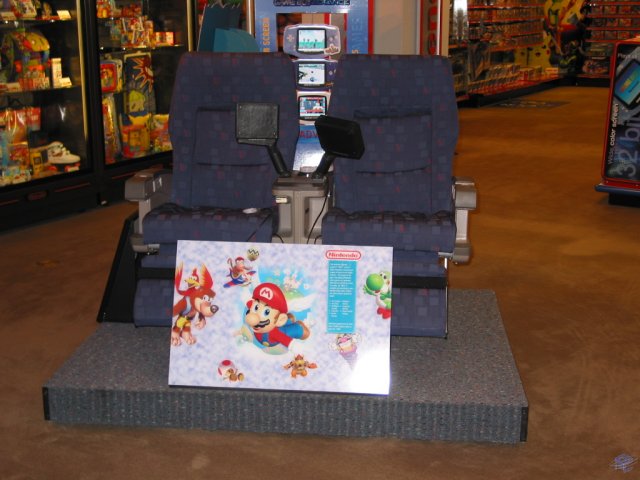 |
| Nintendo Gateway System unit in Nintendo's museum |
There is an extensive article about the airline unit in the February 1994 issue of Nintendo Power. Initially, they had to cut down the capabilities to allow it to work within the confines of the airline. One of the initial limitations was that it could only handle 16 Meg games, as they were downloaded to a 2 MB RAM storage unit (so later titles like Donkey Kong Country would not have worked on the initial version of the system). They had a couple of pictures of the initial system:
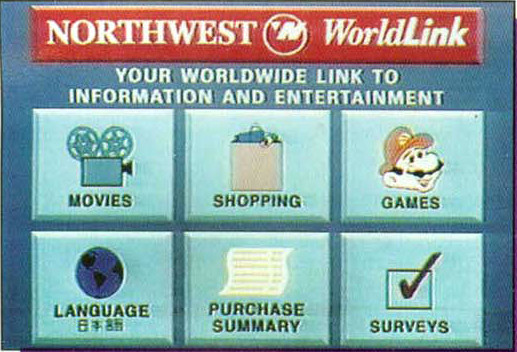 |
| Main screen of the initial Nintendo Gateway System for airlines. Scan courtesy of Retromags. |
 |
| Controller from the initial version of the system. Scan courtesy of Retromags. |
There were apparently two known hardware units that use the system for airline entertainment: The Panasonic System 2000E and Rockwell Collins' 150/150i. Rockwell Collins has manuals for their unit on their website, but at $2000+ each, we aren't going to be seeing those anytime soon. Given that price, you can only imagine what they charged for the system itself.
According to a Popular Science article from December 1993, they charged $4 per hour for games, and they were stored on a single floppy disc. If the article is to be believed, the central computer running the system was driven directly by the SNES hardware, which may have meant it had the capability of running streaming audio (think MSU-1).
 |
| Popular Science article - December 1993 |
However, it probably was running on a DOS based system. Here is an anecdote from Chris Covell's website:
Along the way, I was able to play one of the fabled entertainment systems installed in the back of the airplane's seats: a PC-based map viewer and a Super Famicom with a selection of games. That was cool, but I crashed the software somehow (that's how I know it was a regular DOS (?) PC), and I was expecting the plane to crash anytime soon, or at least get chewed out for something... but no problem. The system came back on in a few minutes and I had one more go of Shanghai before we landed.
The Nintendo Gateway system was mentioned in the Spanish video game magazine Hobby Consolas in 1994:
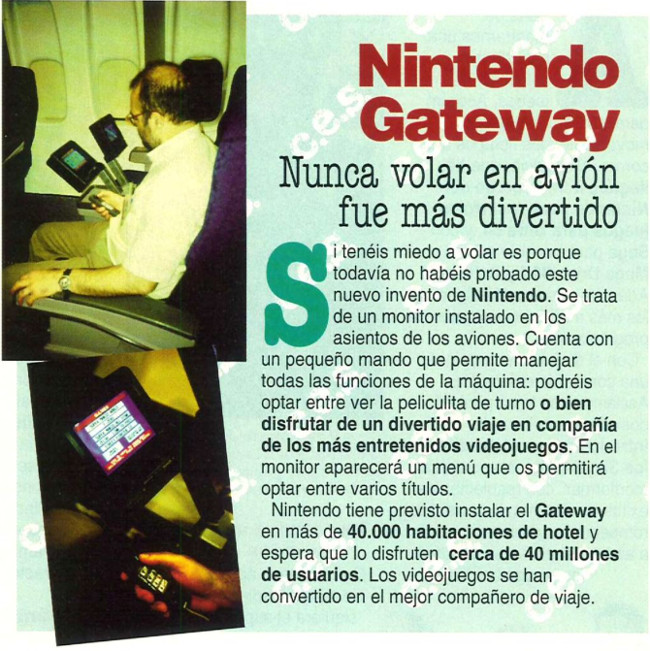 |
| Hobby Consolas #35, September 1994 (Thanks to DillyDylan for the scan) (click here for bigger scan) |
Ricky, from my Discord server has translated the article for me.
Flying in an airplane has never been more fun.
If you're afraid of flying, it's because you have not yet tried this new invention from Nintendo. It's a monitor installed on the seats of the airplane.
It has a small controller that allows you to handle all the functions of the machine. You can choose between watching a movie or enjoying a fun trip in the company of the most entertaining video games. On the monitor, a menu will appear that will allow you to choose between several titles. Nintendo plans to install the Gateway in more than 40,000 hotel rooms and expects close to 40 million users to enjoy. Video games have become the best travel companion.
Alas, since it is 2015, it is unlikely this system is still widely used in airlines. Luckily, we do have a couple of screenshots of the system in action on an Air Canada flight. Thanks to Jorpho for sending me these pictures. There is a good overview of his experience on a post on Digital Press.
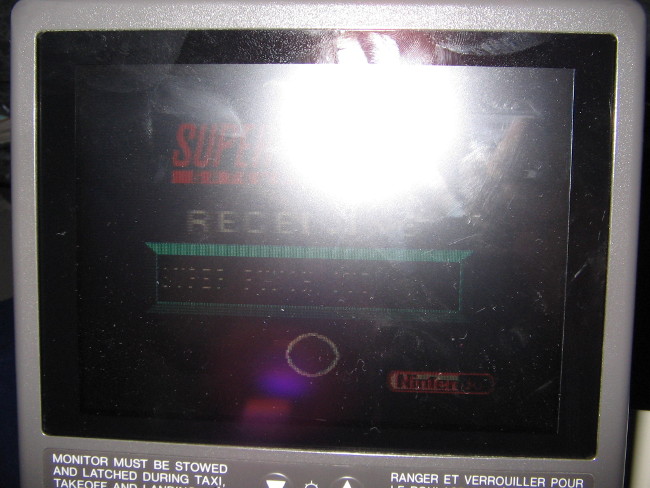 |
| Loading screen |
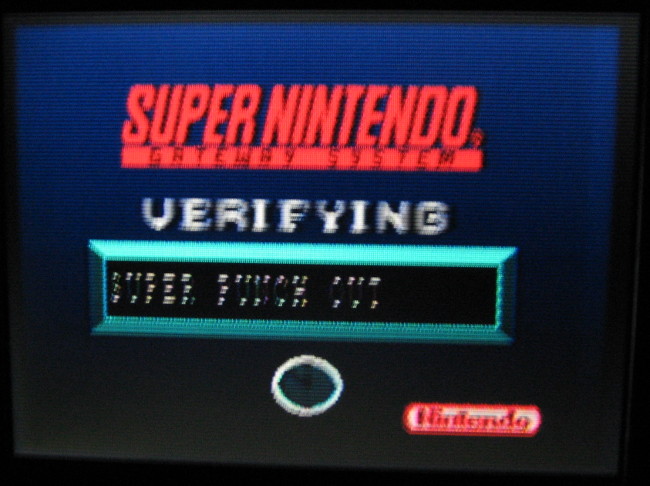 |
| Verifying the download (I assume) |
 |
| Controller used with the Nintendo Gateway System. Fairly similar to controllers you still find in airline entertainment units. |
Nintendo Gateway System for Hotels
According the Nintendo Gateway System website, there were at least three companies that provided hotel units with the system. The most common one is Lodgenet, which apparently had well over half a million SNES units installed as of 1998 (according to Lodgenet's corporate newsletter). According to the article in the November 1994 issue of Nintendo Power, they had began beta testing of the Lodgenet system in early 1994. I found a Reddit thread that explains how it works:
As far as the SNES, N64, and GameCube are concerned, the games are stored on a central server in the LodgeNet equipment rack in the hotel's underbelly. The controller connects to the internal card (or set top box on older systems) that handles all the LodgeNet traffic for movies, games, music, etc. and the game plays from the central server.
Again, since it is 2015, there isn't likely to be a lot of these units in existence anymore. I did find some images of the unit booted up on a web forum dedicated to a webcomic called Platypus Comix:
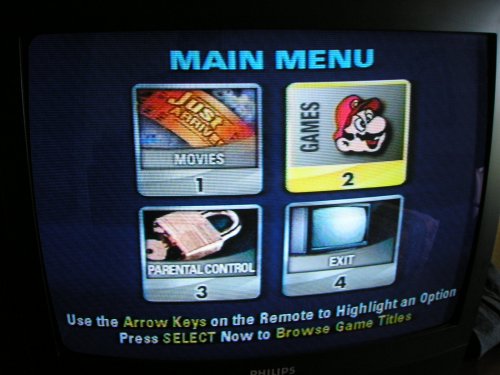 |
| Main menu |
 |
| Yes, the Lodgenet service was pretty pricey... |
There is also an image of the system running on the cover of the second issue of Lodgenet's corporate newsletter (circa late 1997). I've cropped it below. Obviously the main interface went through revisions, as it differs from the above image.
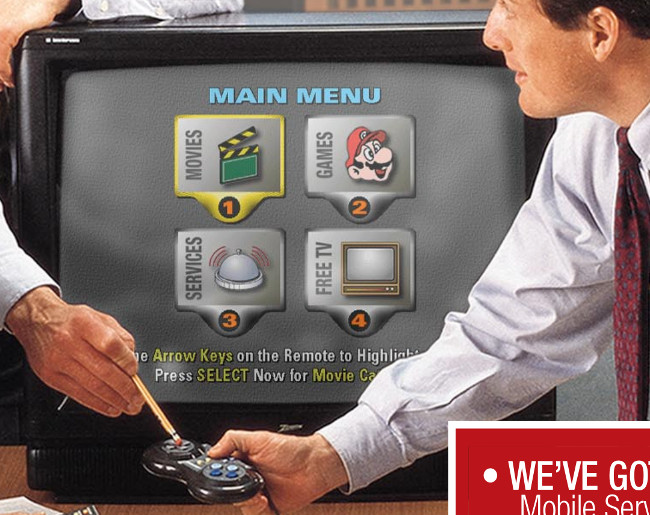 |
| From Lodgenet's corporate newsletter |
The hotel unit hardware is actually not hard to come across. Matthew Callis bought one and sent me these pictures. Note that the controller is not a standard SNES controller, the cord is more like an phone cable cord.
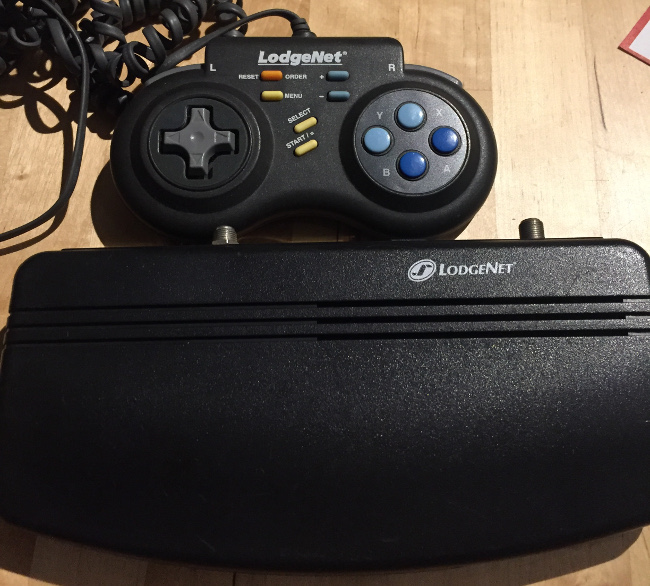 |
| Top of the unit, and controller |
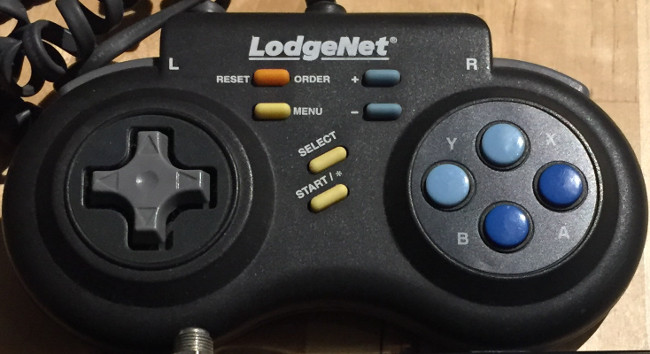 |
| Closeup of the controller |
 |
| Back of the unit |
Exclusive games
Given the casual nature of the audience of the Nintendo Gateway System, it is probably not surprising that Nintendo made a few simple games targeted directly for the system. None of these games were available commercially, and it is entirely possible that we will never get to see these in action (save Noughts & Crosses), given the duration of time since this service was in use.
Noughts & Crosses
This is the only game of the three exclusives that has been discovered. DreamTR owns a copy of this, and has kindly provided some pictures for SNES Central. In the old article of this, I mistakenly called it "Naughts & Crosses". At any rate, it is just a fancy version of Tic-Tac-Toe. The cart the game is on is a SA-1 flash cart. It almost seems like overkill to use the SA-1 for Tic-Tac-Toe, but there it is. The 1998 copyright screen suggests that this was made as an update to appeal to the airline service, that would not be able to upgrade to the N64 the same way that Lodgenet was able to. Here is the description of the game in the instruction manual:
Revisit your school days and experiences the fun of Noughts & Crosses! Your objective as "X" is to make a solid line before your "O"pponent. Winning five games on each grid size moves you to the next challenging level. Select the timer option to limit the time a player has to place a piece.
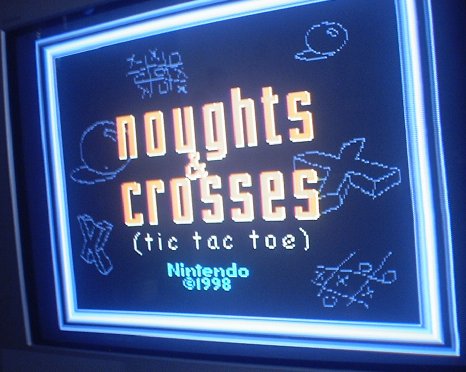 |
| Title Screen |
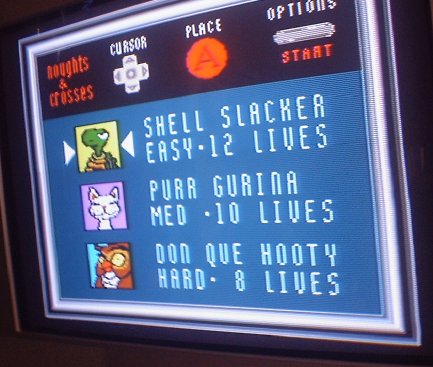 |
| Difficulty levels |
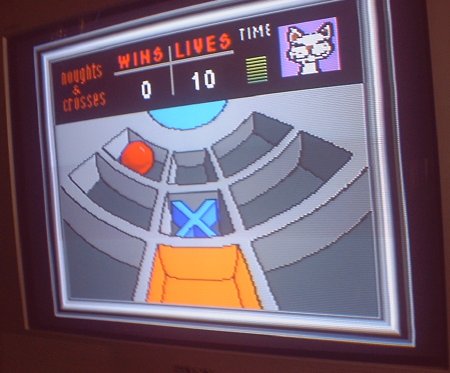 |
| Gameplay |
 |
| Picture of the cart |
Hangman
There is no information on this game aside from the description in the instruction manual.
Hangman is a word guessing game where the player chooses the letter of a mystery word until that word is complete. If the player misses a certain number of letters, the player loses one "life."
There are five levels and the player must correctly guess five (5) words to go to the next level.
Postcard Puzzle
Like Hangman, there is no information on this game aside from what is written in the instruction manual.
Slide tiles around to reassemble the original Postcard image. Only tiles that are adjacent to an empty space can be moved. A timer keeps track of your best time. There are two grid levels, Easy (4 x 4) and Hard (8 x 8).
Dr. Mario
Although Tetris & Dr. Mario was available on the Nintendo Gateway System, Nintendo also included a stand-alone version of the game for the system. Unlike the above titles, this was available on the Nintendo Power service in Japan. Here is a screenshot from that version:
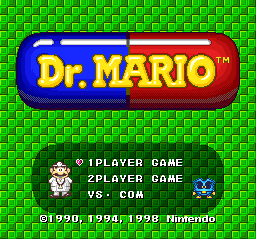 |
| Dr. Mario - note the 1998 copyright. |
List of games
This is a list of games that were used in the Nintendo Gateway System. Links go to PDFs with instructions that were on the old website for the service. There were different games available depending on whether the TV standard was PAL or NTSC (obviously), but the airline system also had a subset of games that were not the same as in hotel.
| Game Name | License Duration | NTSC | PAL | Airline | Notes |
|---|---|---|---|---|---|
| Blackthorne | Unlimited | x | x | x | PAL version called "Blackhawk" |
| Boogerman | Unlimited | x | |||
| Boxing Legends of the Ring | 2005/04/29 | x | x | ||
| Brainies, The | 2009/02/23 | x | x | x | |
| Clay Fighter 2: Judgement Clay | Unlimited | x | x | ||
| Clay Fighter: Tournament Edition | Unlimited | x | |||
| Claymates | Unlimited | x | x | ||
| Donkey Kong Country | Unlimited | x | |||
| Donkey Kong Country 2: Diddy's Kong Quest | Unlimited | x | x | ||
| Dr. Mario | Unlimited | x | x | x | Exclusive game |
| Final Fight | Unlimited | x | x | x | |
| F-Zero | Unlimited | x | x | x | |
| Hagane | 2010/03/31 | x | x | ||
| HAL's Hole in One Golf | Unlimited | x | x | x | |
| Hangman | Unlimited | x | x | x | Exclusive game |
| Killer Instinct | Unlimited | x | x | ||
| Kirby's Dream Course | Unlimited | x | x | x | |
| Legend of Zelda, The -- A Link to the Past | Unlimited | x | x | x | |
| Lost Vikings II | Unlimited | x | x | ||
| Lost Vikings, The | Unlimited | x | x | ||
| Mega Man X | Unlimited | x | x | x | |
| Noughts & Crosses | Unlimited | x | x | x | Exclusive game |
| Panel de Pon | Unlimited | x | x | ||
| Postcard Puzzle | Unlimited | x | x | x | Exclusive game |
| Prehistorik Man | 2009/02/23 | x | x | x | |
| Pro Mah Jong Kiwame | Unlimited | x | x | ||
| Shanghai II: Dragon's Eye | 2010/12/31 | x | x | ||
| Street Fighter II | 2002/01/25 | x | x | ||
| Street Fighter II Turbo | Unlimited | x | x | ||
| Super Adventure Island | 2010/03/31 | x | x | x | |
| Super Bonk | 2010/03/31 | x | x | ||
| Super Ghouls 'N Ghosts | Unlimited | x | x | x | |
| Super Mario All-Stars | Unlimited | x | |||
| Super Mario All-Stars & Super Mario World | Unlimited | x | |||
| Super Mario World | Unlimited | x | x | ||
| Super Metroid | Unlimited | x | x | ||
| Super Play Action Football | Unlimited | x | x | ||
| Super Punch-Out!! | Unlimited | x | x | ||
| Super Soccer | Unlimited | x | x | ||
| Super Solitaire | 2011/09/29 | x | x | ||
| Super Street Fighter II | Unlimited | x | x | ||
| Super Tennis | Unlimited | x | x | ||
| T&E True Golf Classics: Pebble Beach | Listed in the Nintendo Power article, unknown availability | ||||
| Tetris Attack | 2009/12/20 | x | x | x | |
| Tetris & Dr. Mario | 2009/12/20 | x | x | x | |
| Vegas Stakes | Unlimited | x | x | ||
| Wario's Woods | Unlimited | x | x | x |
Bibliography
- Nintendo Power, Special Feature - Gateway, Publication date: February 1994, Volume: 57, Pages: 52-53
- Popular Science, Electronics, Publication date: December 1993, Volume: -, Pages: 37
- Picture of the system in an article from Planet Gamecube (link)
- Thread by Jorpho on the Nintendo Gateway System on Digital Press (link)
- Thread on the Lodgenet system, which is pretty much the same as the Nintendo Gateway System (link)
- Another thread on Digital Press about it, with one of the members describing the exclusive games (link)
- Nintendo Gateway System website preserved on Archive.org (link)
- some information on the Lodgenet system on the Nintendo Repository (link)